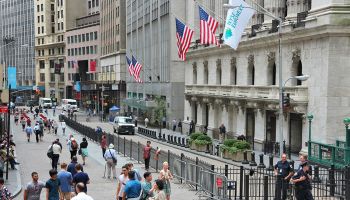Anybody want a bank building?
Banks must handle traditional behemoths with care
- |
- Written by Steve Cocheo

While folks often speak of “Wall Street,” the well-known front entrance of the New York Stock Exchange is actually on Broad Street. And nowadays, in what is still called the “Financial District” you are as likely to meet a dogwalker escorting a schnauzer or chihuahua, an au pair pushing a stroller, or a tour guide leading a 911/Wall Street visitor group as you are a financial services person.
Many of the financial companies that used to fill the Wall Street area buildings with staffs no longer live there, or, if they do, they have moved substantial chunks of their operations elsewhere. Numerous buildings that used to house financial offices are now high-end residential, or have been broken up into much smaller commercial units.
Banking changing look changes real estate needs
To varying degrees, this kind of pattern has been seen in other parts of the country, brought on by changing banking functions and the takeover of many basic banking functions by electronic alternatives. There’s that, and there’s a generational change in expectations going on, too.
Grand, cavernous banking floors, serving as a customer contact point as well as an entrée to upper floors filled with management and functionaries, increasingly don’t matter to customers.
“Years ago, those huge banking facilities symbolized strength and stability,” says Stuart Hicks, who is president of the banking industry group at commercial real estate consultants Jones Lang LaSalle, IP, Inc. “Today, if anything, while the architecture might be cool, you don’t need all that to demonstrate strength and stability. In fact, to the new generation, buildings like that might represent ‘slow and stodgy. They certainly don’t depict agility.”
While the trend in the Wall Street area is perhaps extreme, given the impact of 911 and later Superstorm Sandy, on top of market evolution, Hicks says that “you see things changing across the country.”
Between evolving ways of doing business and increasing mergers and acquisitions, Hicks continues, banks have increasingly faced real estate challenges. When they own such historic structures, and no longer wish to occupy them, they face a shrinking potential market of companies that would be interested in buying them for either their ground floor footprints or their upper-floor facilities.
Often, historic structures suffer, in comparison to newer construction, from bad air flow and lack of natural light, according to Hicks. Modern offices tend to require larger floor plans than the designs of the past. The emphasis is off simple looks and old workflow concepts and much more on the impact of floor plan and structure on workers, he explains.
“Productivity of employees is #1,” says Hicks. That, and the need to retain employees by making their work surroundings more pleasant.
As far as the ground floor is concerned, the challenge is, if a bank no longer wants it but wants to sell the property, the most natural potential market—another bank—is actually the least likely purchaser. Other institutions are just as aware as the seller is of what people expect of a bank these days, and aren’t going to snap up a white elephant.
Potential solutions to pachyderm properties
Hicks says there are several strategies a bank can try when attempting to sell off a surplus or outdated location.
One is to explore the housing market. Hicks says the growing demand for urban properties helps. Recent research has found that young people increasingly want to stay in, or move to, urban locations, rather than the suburbs where their parents live. Older office structures can be converted into condos as well as into hotels.
“That has been a solution for some of these buildings,” says Hicks.
In some cases, former monumental bank lobbies can be divided up into retail space. This space may be especially appealing for companies that want to reach remaining businesses in the neighborhood with their services. Potential lessees include providers such as Fedex and UPS Stores that could cater both to companies as well as households.
Hicks says banks that lease such locations and wish to shrink their footprints while subleasing excess space must explore their obligations under the lease. It may be that any sub-lessee construction or improvements may have to be undone by the bank tenant before it terminates its own arrangement, later on.
When two must become one
In some mergers, a bank may wind up with locations near each other, due to old competitive branching strategies. While the structures themselves must be taken into account, Hicks says it is most important to study the demographics and traffic patterns of the two locations.
A location with better numbers trumps one that appears to have size or flexibility on its side. It’s also important to compare how easily the bank can get out of either location, which may involve weighing the relative timing of selling an owned building versus getting out of a leased location.
Hicks notes that larger banks today tend to lean towards leased properties, while smaller and midsized institutions tend to lean toward owning their locations.
“The beauty of a lease clause is that it expires someday,” says Hicks.
Institutions that own buildings can explore sale-leaseback transactions, but that requires a buyer who sees the building as attractive even after the bank—today a built-in tenant— someday decides to stop leasing the location and go elsewhere. But sale-leasebacks do grant the bank flexibility.
Remember the goal
Hicks points out that it is important to not lose sight of the intent of the tactics and strategies. A firm like Jones Lang sees its mission for clients in such situations as finding the best course to get the bank to its real goal: rightsizing its physical network’s locations.
“Helping them to do that is more important,” says Hicks, “than the individual transactions,” says Hicks.
Tagged under Management, Duties, Feature,













